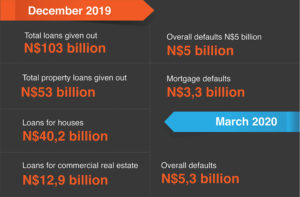
By Lazarus Amukeshe and Ngiinomenwa Erastus | 3 July 2020
UNPAID property market bank loans have hit an all-time high, raising concerns that it could threaten the stability of the banking sector.
The Bank of Namibia, however, feels there is no need to worry at this stage, although its statistics indicate the property market is increasingly becoming a burden for banks.
At the end of 2019, Namibian commercial banks reported that N$5 billion in loans they gave out were no longer generating income.
Most of these loans – N$3,3 billion – were given out to buy houses or to fund commercial properties.
In total, banks issued N$103 billion in loans, with N$53 billion pumped into the property sector, which is increasingly seeing poor to no performing loans at all.
A loan is considered as non-performing when a borrower has not paid either the capital amount or interest for over three months.
A high concentration of ‘non-performing’ loans also affects the income of banks.
Since banks use public funds deposited with them to extend these loans, an increase in inactive loans can also pose a threat to the safety of deposits, and ultimately the financial stability of a country.
The Bank of Namibia has emphasised that stability is important as it signals to the public that their money, including pension savings, is safe.
The central bank has a general rule that the banking industry’s non-performing loans should not exceed 4% of their loan book.
Loans passed this mark last year, closing the year at 4,8%. At the end of March this year, they were at 5,2% or N$5,3 billion.
With the impact of Covid-19 yet to be factored in, analysts predict anything above 6%.
According to Moody’s Investor Service, non-performing loans are set to continue increasing over the next 12 to 18 months due to the coronavirus pandemic that is expected to exert further pressure on Namibia’s economy, which was already falling short of growth rates providing banks with good business opportunities.
These loans have increased from 1,6% of the total loan book from four years ago.
The Namibian’s analysis of 15 years of data produced by the Bank of Namibia shows that although property loans always have the most defaults, they also brought in the most interest income for commercial banks – N$35,3 billion in the last 10 years.
Property loans are at least four times bigger than other loan categories. Bank of Namibia in its annual report last year said this exposure makes banks vulnerable to the drop in housing prices.
Despite last year’s warning, the central banks recently said the country’s financial stability is, however, not under threat.

The big four banks have not answered specific questions since September last year and have said the public should wait until their 2020 financial statements are released.
“Kindly note that we are in a closed reporting period and cannot respond to these questions,” FNB Namibia’s spokesperson Elzita Beukes said last month.
A similar answer was given by Bank Windhoek’s spokesperson, Andre le Roux.
Nedbank spokesperson Selma Kaulinge said they were unable to provide information yet.
Standard Bank Namibia did not respond to questions.
Among key questions was a request for comment on the rise in non-performing loans and the measures they have brought in place to remedy the situation.
WARNING BELLS
Sanlam Namibia investment portfolio manager Basson van Rooyen told The Namibian last year that, “with the average Namibian mortgage bond holder under pressure, it means one of the major income streams for the banks is under pressure.”
The Bank of Namibia has said it is aware of the fact that the economic slowdown has resulted in an increase in non-performing mortgage loans. However, their monitoring exercises indicated it “does not need to be worried”.
It acknowledged that a 6% ratio – as forecast by Moody’s – would signal “abnormal conditions” in the economy.
Exposure to a stagnant property market and a rise in non-performing mortgage loans are on the central bank’s radar, but they are not worried yet, the regulator’s spokesperson, Emma Haiyambo, said.
“The Bank of Namibia generally carries out various stress testing exercises to establish at what level of non-performing loans it should become worried. These exercises revealed that at the current level the bank does not need to be worried that capital might be reduced,” she said.
WHY DOES IT MATTER?
There were seven commercial banks in Namibia at the end of last year, with the sector’s top four – First National Bank Namibia, Standard Bank Namibia, Bank Windhoek and
Nedbank Namibia – owning 98% of total bank assets.
Standard Bank Namibia had the highest ratio of non-performing loans – 6,5% – last year, followed by Bank Windhoek, which closed 2019 at 3,9%.
Nedbank Namibia clocked in at 4,3% in 2018 and the 2019 figures are not yet available.
FNB Namibia – at 2,8% – had a lower proportion of loans in the red last year.
An increase in the number of people not repaying property loans can corrode the quality of performing loans – based on the premise that the higher the rate of non-payments, the bigger the risk that others will follow suit.
Commercial banks do, however, create reserve facilities specifically for these kinds of situations.
Namibia’s banks had set aside N$974 million and had N$3,4 billion in collateral.
If the entire N$5,3 billion becomes bad apples, the difference is expected to be funded by the capital owners have put up, and reserves built up over the years.
Central bank figures at the end of March showed that the banking sector is largely funded by N$107,6 billion in deposits from members of the public, companies and organisations, while their capital and reserves amounted to N$16,6 billion. At least 85%
of these deposited funds were issued as loans.
The more the deposits are used up as loans, the less banks are able to give out in new loans as well as manage liquidity risks.
Increases in customers not repaying their mortgages could threaten the ability of banks to repay demand deposits, which dominate commercial banks’ funding at N$50,9 billion.
Deposits can be withdrawn at short notice and, in a worst-case scenario, can render banks unable to meet this obligation.
SHAKY GROUND
The fragility of mortgage investments seems to have gone undetected during the lending boom between 2013 and 2015.
Bank of Namibia data shows that the double-digit growth of banks’ mortgage income tailed off significantly from a high of 36% (N$1 billion) in 2015 to single-digit growth in each of the last three years.
Last year’s growth of 8% (N$424 million) was propped up by 11% (N$423 million) growth in earnings from residential property loans. Income growth from loans to the commercial property sector barely rose, reflective of the tough economy.
Growth in interest income from mortgages has fallen sharply, from N$663 million in 2016 to N$424 million last year.
NOT WORRIED… YET
The coronavirus pandemic is likely to increase unemployment and limit wage growth, and debt service costs for households will rise and increase the probability of defaulting, Moody’s said.
The central bank’s Haiyambo noted that in abnormal circumstances, a benchmark of 6% non-performing loans ratio is applied.

“If such levels start appearing, the regulator will … institute supervisory actions to remedy such a situation,” she said in May this year.
The growth in non-performing loans first spiked alarmingly in 2017, rising by 73% from 2016. In 2018, it grew by 53% and last year by 44%.
Financial analysts and economic observers mainly blame the bad economic conditions.
Head of research at PSG Wealth Namibia Eloise du Plessis said Namibia’s banks were well funded, and drew some confidence from the quality of collateral put up by borrowers.
She said Namibia’s banks had good risk management, and the situation could have been markedly worse if this was not the case.
Robert McGregor, an analyst at Cirrus Capital, said should current trends continue, there would be cause for concern.
He said because banks had reacted cautiously to increases in defaulting, there was no immediate danger posed.
* This article was produced by The Namibian’s investigative unit with support from Finance Uncovered.





